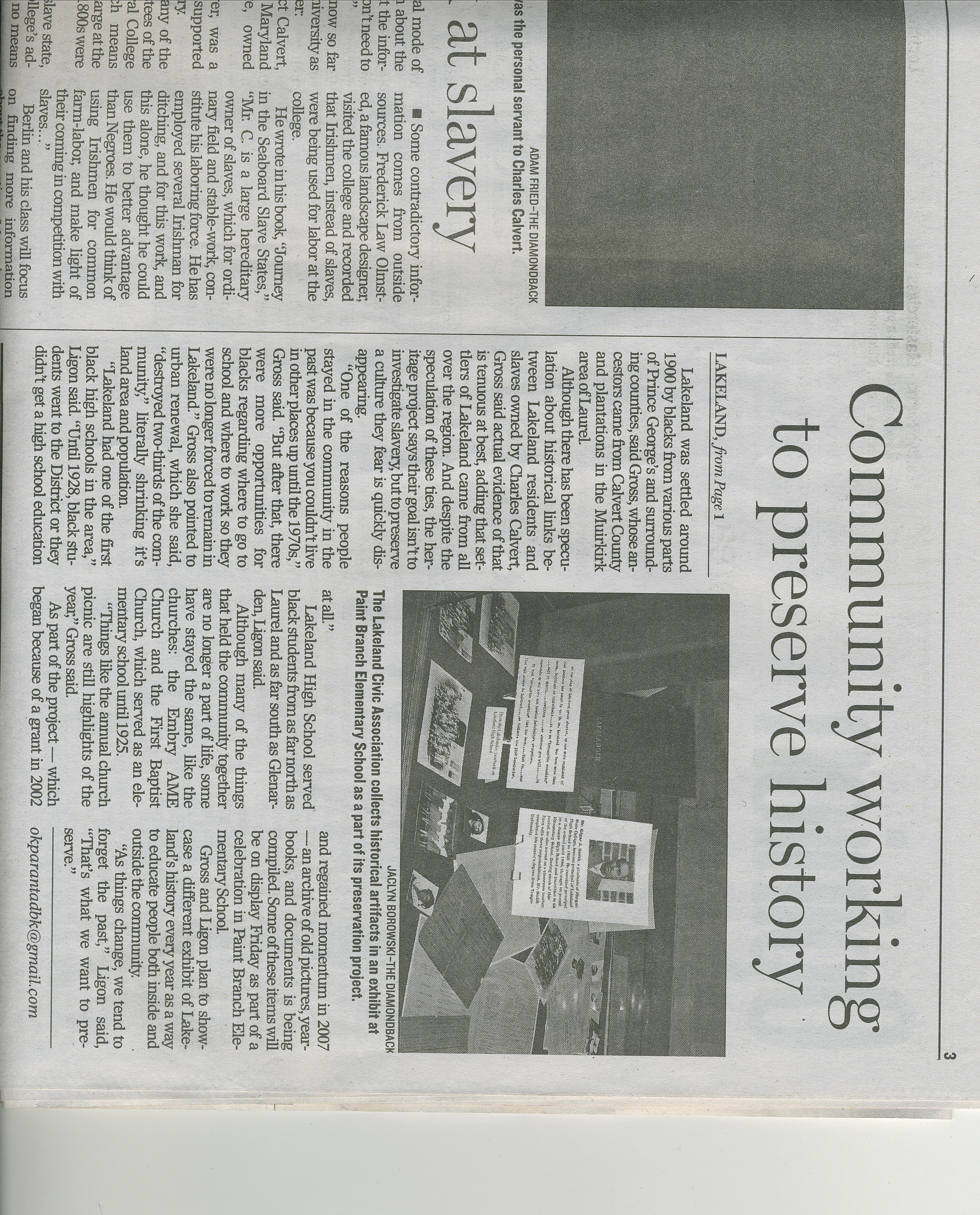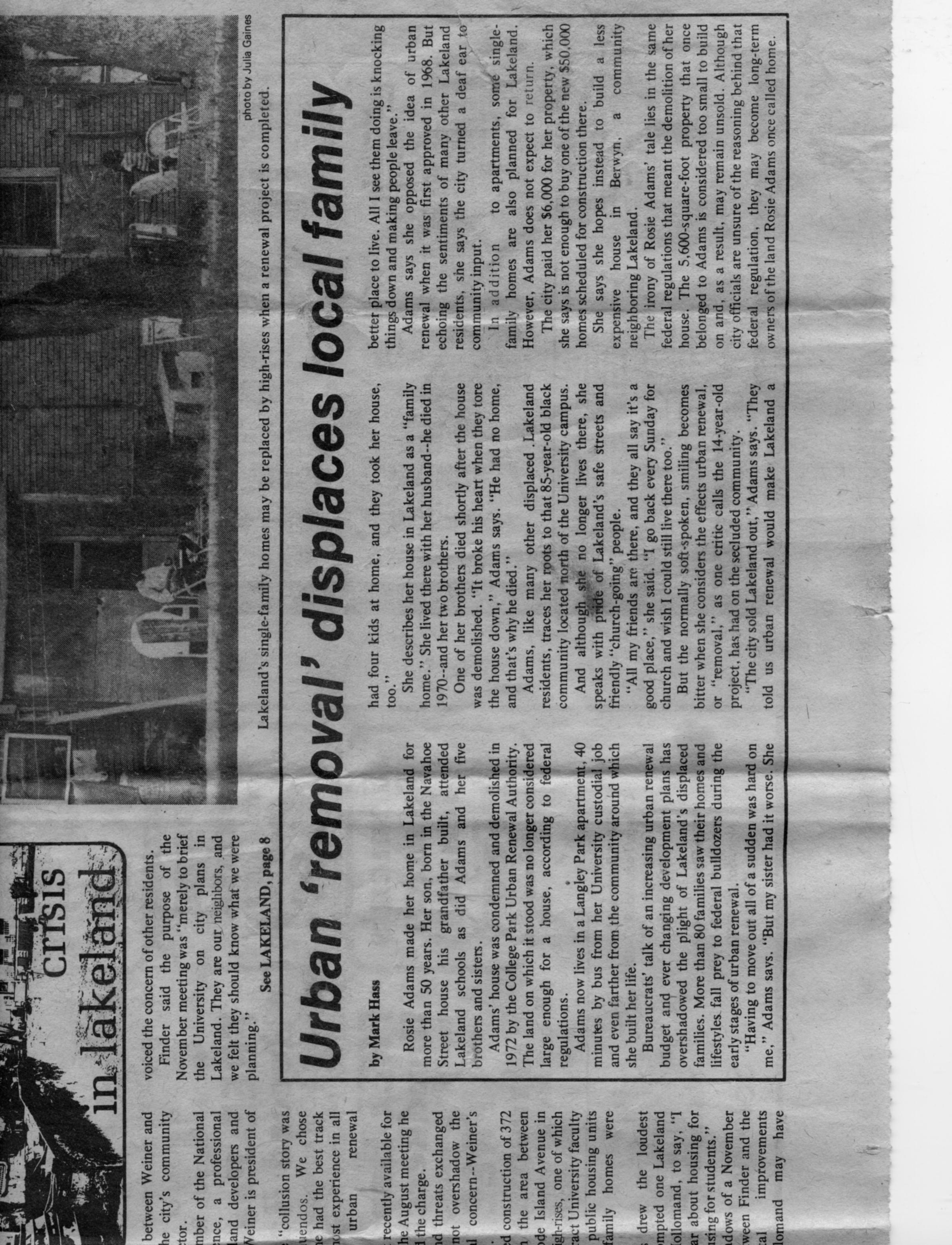Removal’ displaces local family
Clipping from the collection of Mary Sellers. From a series of Diamondback articles on urban renewal.
Clipping from the collection of Mary Sellers. From a series of Diamondback articles on urban renewal.

The Diamondback September 15, 1976 Many pieces of Lakeland land were purchased by the Urban Renewal project. The University then discusses the use of Lakeland land for the expansion of their community housing through the Urban Renewal project. This idea is presented by the city community development director, Mr. Edwin Finder. In the meantime, some Lakelanders must rent homes from the city because of the Urban Renewal project’s purchase of their homes. Mr. Finder says that they are to be given first priority in the construction of new housing. At the same time, the Urban Renewal plan exceeded its budget of $5.2 million by another $5 million. The city requested $1.8 million in urgent need funds from the U.S. Department of Housing and Urban Development (HUD) and was approved to receive it to complete the project. The request was sent to the HUD’s office earlier in the summer of 1976. Getting more federal money to complete the project was imperative and was a way to help fix the damage already afflicted on the neighborhood by natural incidents. Mrs. Hollomand part of the Lakeland resident's group stated opposition to the University's involvement in the project. She said the residents had need for new housing.
Clipping from the collection of Mary Sellers.
Clipping from the collection of Mary Sellers.From a series of Diamondback articles on urban renewal.
Clipping from the collection of Mary Sellers. From a series of Diamondback articles on urban renewal.

A scrapbook dating from June 1969-1979. Mainly newspaper clippings (obituaries, articles), birthday cards, letter to parents of Lakeland Elementary School children (Pearl Lee Campbell Edwards was a parent of a student), a presentation by Pearl Lee to get Paint Branch built. Newspaper clippings of popular tv program hosts obituaries, events happening in Lakeland community (ex., 'first demolition in Lakeland', 'Lakeland Urban Renewal Project'), response to letter on desegregation plan, editorial on 'Saving Lakeland.'

The community of Lakeland and its members want to preserve its history by and through LHP. The project members plan to display artifacts from collections every year and preserve the past.

The Diamondback April 21, 1978 Page 1 Portion of article by Mark Hass Rose Adams lived in Lakeland for more than 50 years. Her son was born in a house built by his grandfather on built on Navahoe Street. In 1972 that house was demolished by the City of College Park. Mrs. Adams has moved to an apartment in Langley Park a 40 minute ride from her job as a custodian on the University campus. The family's Lakeland house was a "family home." were she had lived with her husband and two brothers. One of them died soon after the house was demolished. Adams said "It broke his heart when they tore the house down'" "He had no home, and that's why he died." Mrs. Adams says she still has friends in Lakeland and goes there for church on Sundays. About the project she says "The city sold Lakeland out" "They told us urban renewal would make Lakeland a better place to live. All I see is knocking things down and making people leave." Mrs. Adams was paid $6,000 for her home. That was not enough to buy one of the $50,000 new homes planned to be built.

The Diamondback October 19, 1971 Page 4 Dean Tuthill Responding to letter in the October 7 edition on channelization of Paint Branch and Indian Creek form the Environmental Conservation Organization. I am in support of channelization as it would benefit the residents of Lakeland. I have witnessed people rescued from their homes in boats and spoken to residents afraid when it rains. Those living on Lakeland Road have been subject to flooding for years and commitments have been made of help from the Corps of Engineers project. It is true no one should live in a know flood area but Black people live there because they had no other option. Much of the land is owned by whites living elsewhere. Purchasing the land using eminent domain is the only way to put land in the hands of community members. Once that is done young residents will have a chance to purchase land and build homes in Lakeland. If not this plan would the Environmental Conservation Organization ensure the avaliblity of low income homes for Black people in Collège Park Woods, College Park Estates, Berwyn or Berwyn Heights? For now Lakeland residents hope to improve their community.

The Diamondback publishes a piece on urban renewal in the city of Lakeland. It highlight's the commitment of Lakeland residents to preserving the neighborhood.
Clipping from the collection of Mary Sellers. From a series of Diamondback articles on urban renewal.

The Diamondback April 21, 1978 Page 1 by Mark Haas Crisis in Lakeland There was upset when Leon Weiner, a Wilmington developer was chosen to complete work on the Lakeland urban renewal project. Community members preferred a local builder. HIs plan would provide tow high rise buildings and only six single family homes. Community leaders felt there was collusion involved in the developer's selection. In answer Weiner threatened a slander suit. Residents were most displeased with the inclusion of two high rise buildings. This comes on the heals of a meeting between the city and University discussing the Lakeland plans. In 1974 the University offered a joint student development project in Lakeland. That proposal was publicly turned down. At that time the urban renewal plan called for apartment buildings on the east side of the railroad in Lakeland. City officials said community members would be able to relocate in the central conservation area and 30 building lots would be available there this year. Project Area Committee (PAC) spokesman Leonard Smith and other residents made known their desire to return to the original development plan with more single family homes. Smith said "Why should the community be forced to bear the weight of the money problems when we did nothing to cause it? Why should we be hurt by it?
Clipping from the collection of Mary Sellers. part one of clipping
2nd half of clipping. Clipping from the collection of Mary Sellers. From a series of Diamondback articles on urban renewal.
Clipping from the collection of Mary Sellers. From a series of Diamondback articles on urban renewal.